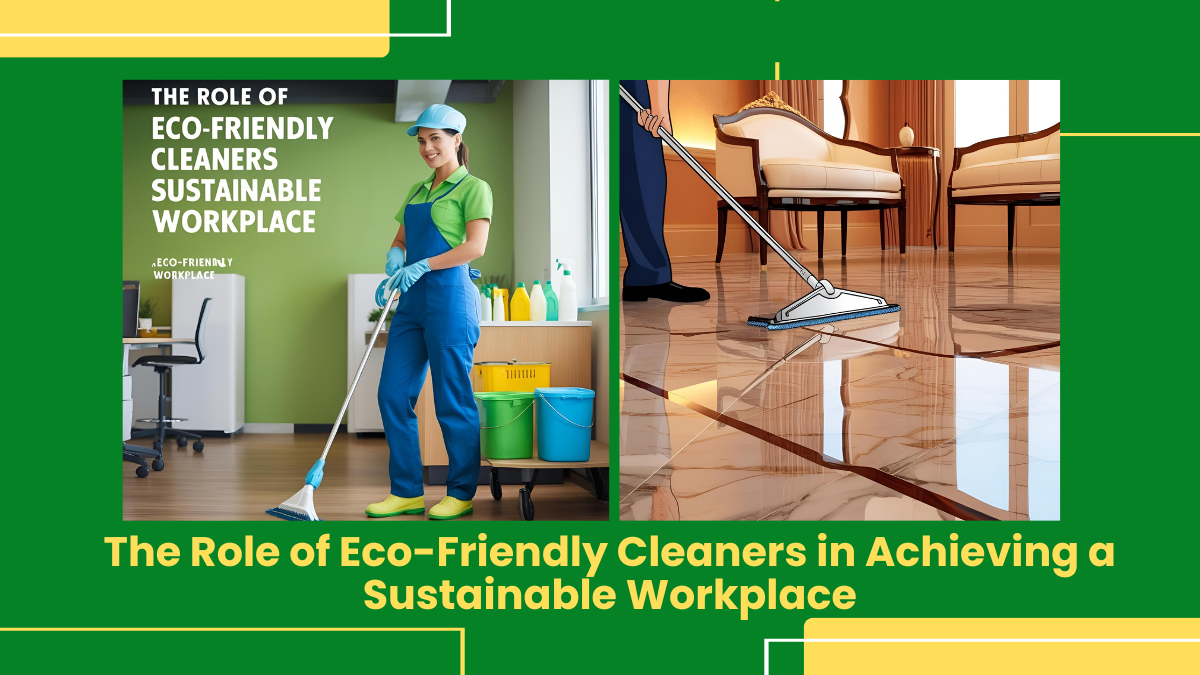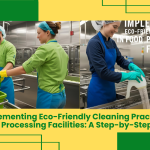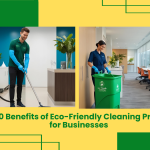Creating a sustainable workplace is essential for organizations committed to health, safety, and environmental responsibility. A key element of sustainability is the choice of cleaning products and procedures. Eco-Friendly Cleaners play a crucial role in reducing harmful chemical exposure, supporting employee well-being, and lowering the environmental footprint of routine cleaning operations. This comprehensive guide explores the problems associated with traditional cleaning, offers practical solutions, and provides prevention tips for long-term success. It also explains how integrating digital signage through platforms like Ecochem can streamline communication and reinforce sustainable cleaning practices.
The Importance of Sustainable Cleaning Practices
In many workplaces, the methods used for cleaning can have a significant impact on both the environment and employee health. Traditional cleaning products often contain chemicals that may cause respiratory problems, skin irritations, and other health issues. They also generate hazardous waste that poses risks to ecosystems. By contrast, Eco-Friendly Cleaners use naturally derived, biodegradable ingredients that ensure a safer, healthier workplace. Adopting sustainable cleaning practices not only helps protect human health but also contributes to global efforts to reduce pollution and conserve natural resources.
Why Eco-Friendly Cleaners Matter
- Health Benefits: The use of Eco-Friendly Cleaners minimizes exposure to harmful substances for employees, patients, and visitors.
- Environmental Impact: These cleaners reduce chemical runoff and waste, contributing to improved air, water, and soil quality.
- Regulatory Compliance: More organizations are held to higher standards for health and environmental protection; sustainable cleaners help meet these regulations.
- Corporate Reputation: Companies that invest in sustainable practices build trust and credibility with stakeholders, customers, and the community.
Sustainable cleaning is a significant step towards a greener and safer work environment. With heightened public awareness about environmental issues, the demand for Eco-Friendly Cleaners has grown as businesses aim to reduce their ecological footprint while maintaining high cleanliness standards.
Problems Associated with Traditional Cleaning Methods
Many workplaces have relied on conventional cleaning methods that rely on chemical agents harmful to both people and the environment. Below are some of the key challenges associated with traditional cleaning methods:
1. Health Hazards from Toxic Chemicals
Problem:
Traditional cleaning products often contain chemicals that can trigger allergic reactions, respiratory issues, and skin irritations. Prolonged exposure to these substances is a significant risk for employees and frequent visitors.
- Employee Wellness: Staff exposed to chemical residues may suffer from chronic conditions, reducing overall productivity.
- Patient and Visitor Risk: In environments such as hospitals, toxic residues can aggravate pre-existing health conditions.
- Workplace Absenteeism: Increased health problems can lead to more frequent sick days and higher medical costs.
2. Environmental Degradation
Problem:
The disposal and runoff of traditional cleaning agents contribute to environmental pollution. Chemicals from these products can seep into water sources, contaminate soil, and disrupt local ecosystems.
- Water Contamination: Harmful substances can pollute water bodies, affecting aquatic life.
- Soil Degradation: Chemical residues can alter soil composition, reducing its fertility and affecting plant life.
- Long-Term Impact: Persistent chemicals may remain in the environment for years, causing sustained ecological damage.
3. High Operational Costs
Problem:
While traditional cleaning products may seem cost-effective initially, the long-term expenses related to health issues, environmental remediation, and regulatory fines can be significant.
- Indirect Costs: Health-related absenteeism and lower productivity contribute to increased operational expenses.
- Waste Disposal: The costs associated with proper disposal of hazardous waste add up over time.
- Compliance Issues: Failing to meet regulatory standards can result in fines and legal complications.
4. Inadequate Cleaning Efficiency
Problem:
Some conventional cleaning methods are not efficient in removing certain pathogens or contaminants, particularly in high-risk environments. This inefficiency can lead to recurring cleaning issues and elevated infection risks.
- Persistent Pathogens: Ineffective cleaning can leave behind harmful microorganisms that lead to recurring infections.
- Repetitive Efforts: The need for repeated cleaning cycles increases labor and resource consumption.
- Operational Disruption: Inefficient cleaning practices can interfere with daily operations, especially in environments requiring strict hygiene.
5. Limited Employee Engagement
Problem:
Traditional cleaning methods often lack a system for consistent communication and training, leading to misunderstandings and non-compliance with safety protocols.
- Inconsistent Procedures: Without clear guidelines, employees may not follow best practices.
- Training Gaps: Lack of ongoing training can result in outdated cleaning techniques and safety practices.
- Communication Breakdown: Inadequate communication of protocols increases the risk of errors and accidents.
Solutions: Transitioning to Eco-Friendly Cleaners
Switching to Eco-Friendly Cleaners is a practical solution that addresses the problems posed by conventional cleaning methods. Here are some effective strategies for making the transition:
1. Invest in Certified Eco-Friendly Cleaners
Solution:
Opt for cleaning products that are certified for being eco-friendly and safe for both human health and the environment. These products often come with certifications that verify their non-toxic, biodegradable nature.
- Certifications and Standards: Look for certifications like EPA Safer Choice or equivalent standards.
- Ingredient Transparency: Choose products with clearly disclosed ingredients and minimal synthetic chemicals.
- Supplier Reputation: Work with trusted suppliers who specialize in sustainable cleaning solutions.
Prevention Tip: Regularly update your inventory with the latest certified Eco-Friendly Cleaners and review supplier performance.
2. Implement Staff Training and Awareness Programs
Solution:
Educate employees on the benefits and proper usage of Eco-Friendly Cleaners. Regular training ensures that everyone understands the importance of sustainable cleaning practices and follows standardized protocols.
- Comprehensive Training: Organize hands-on workshops to demonstrate the use of eco-friendly products.
- Safety Protocols: Train staff on safe handling, storage, and emergency procedures for eco-friendly cleaning agents.
- Continuous Education: Provide updates on new products and sustainable practices periodically.
Prevention Tip: Schedule regular refresher courses to ensure that all employees remain knowledgeable about the latest sustainable cleaning practices.
3. Develop Clear and Comprehensive Cleaning Protocols
Solution:
Create detailed cleaning protocols that incorporate the use of Eco-Friendly Cleaners in every aspect of the cleaning process. These protocols should be easy to follow and clearly outline each step required to maintain a sustainable workplace.
- Standard Operating Procedures (SOPs): Document procedures for various cleaning tasks.
- Role Assignments: Clearly define responsibilities to avoid confusion and ensure accountability.
- Documentation: Maintain records of cleaning schedules, product usage, and compliance checks.
Prevention Tip: Conduct regular audits to verify that the protocols are being followed correctly and update them as needed.
4. Integrate Digital Signage for Efficient Communication
Solution:
Utilize digital signage platforms such as Ecochem to display real-time cleaning schedules, protocol updates, and safety alerts. Digital signage is an effective tool for ensuring that all employees are well-informed about Eco-Friendly Cleaners usage and procedures.
- Real-Time Updates: Use screens to instantly communicate any changes in cleaning protocols.
- Visual Aids: Display instructional videos and step-by-step guides on proper cleaning techniques.
- Centralized Information: Keep all cleaning-related information in one easily accessible location.
Prevention Tip: Regularly update digital displays to reflect the latest protocols and ensure consistent communication across all departments.
5. Monitor and Evaluate Cleaning Performance
Solution:
Set up systems to continuously monitor the performance of cleaning practices using Eco-Friendly Cleaners. Data analytics can help you track progress, identify issues, and make informed decisions about further improvements.
- Performance Metrics: Measure factors such as infection rates, employee feedback, and overall cleanliness.
- Feedback Mechanisms: Establish channels for staff to report issues or suggest improvements.
- Regular Reviews: Schedule periodic evaluations to assess the effectiveness of the sustainable cleaning program.
Prevention Tip: Use both internal and external audits to maintain objectivity in evaluating cleaning performance.
6. Encourage Sustainable Procurement Practices
Solution:
Adopt procurement practices that prioritize sustainability. Work with suppliers who are committed to providing high-quality, eco-friendly cleaning products.
- Vendor Partnerships: Establish long-term relationships with suppliers known for sustainable practices.
- Bulk Purchasing: Consider bulk purchasing to reduce packaging waste and lower overall costs.
- Sustainability Audits: Periodically review supplier practices to ensure they align with your sustainability goals.
Prevention Tip: Maintain a regular review schedule of supplier contracts and product performance to ensure continued adherence to eco-friendly standards.
7. Promote a Culture of Sustainability
Solution:
Foster an organizational culture that values sustainability and environmental responsibility. This culture should be evident in every department and reinforced through daily practices and communication.
- Leadership Involvement: Ensure that management actively supports sustainable practices.
- Employee Recognition: Reward staff who contribute to successful implementation of sustainable cleaning protocols.
- Community Engagement: Share your sustainability achievements with the broader community to inspire others.
Prevention Tip: Hold regular meetings and sustainability workshops to keep the focus on environmental goals and recognize improvements.
Eco-Greener (Multi-Purpose Cleaner)
Ecochem is growing as a company by offering safe cleaning chemicals at reasonable prices. Our Economical green cleaning products include Eco-Greener – a multi-purpose cleaner. The formulation of user-friendly green cleaning products keeping in mind the safety of users and cleaning staff. Eco-Greener composition offers hygienic and acid-free green multi-purpose cleaning for different areas and spaces.
Eco-Green Kleen (Industrial Degreaser)
Toughest Industrial degreaser is the need of cleansing stubborn greases out of the surfaces. Ecochem has Eco-Green Kleen, which is an eco-friendly chemical product in Mumbai and offers degreasing within minutes. Most of the available tough cleansers contain harsh chemicals that cause enough pollution in the atmosphere and also may lead to an adverse effect on the users with its unique feature of being a water-based formulation.
Prevention Tips for Long-Term Success with Eco-Friendly Cleaners
Maintaining a sustainable workplace through the use of Eco-Friendly Cleaners requires ongoing effort and proactive measures. Here are prevention tips to ensure long-term success:
1. Regular Training and Skill Development
- Continuous Learning: Schedule training sessions at regular intervals to update staff on new eco-friendly cleaning methods.
- Skill Assessments: Conduct periodic evaluations to identify training needs and reinforce best practices.
- Digital Training: Use digital signage to deliver short, engaging training modules and safety reminders.
2. Routine Audits and Monitoring
- Internal Audits: Regularly review cleaning procedures to ensure adherence to protocols.
- Third-Party Reviews: Engage independent evaluators to assess the effectiveness of your sustainable cleaning practices.
- Data Collection: Monitor key performance indicators such as infection control and product usage, and adjust strategies accordingly.
3. Open Communication Channels
- Feedback Systems: Create platforms for employees to share their experiences and suggestions for improvement.
- Digital Alerts: Use real-time digital signage updates to notify staff about any changes or reminders.
- Regular Meetings: Host meetings to discuss cleaning performance, challenges, and potential improvements.
4. Sustainable Product Reviews
- Product Testing: Periodically test new eco-friendly cleaning products to assess their efficiency and safety.
- Supplier Evaluations: Continuously evaluate supplier performance and explore new sustainable options.
- Documentation: Keep comprehensive records of product performance, costs, and environmental impact for future reference.
5. Emergency Preparedness
- Clear Procedures: Establish clear protocols for handling accidental spills or exposure to cleaning agents.
- Drills and Simulations: Regularly conduct emergency drills to ensure staff readiness.
- Digital Support: Display emergency procedures and contact details prominently using digital signage throughout the workplace.
The Impact of Eco-Friendly Cleaners on a Sustainable Workplace
Implementing Eco-Friendly Cleaners can transform workplace environments by improving health, reducing environmental impact, and cutting long-term costs. The benefits extend across several dimensions:
Health and Safety Improvements
By reducing exposure to toxic chemicals, Eco-Friendly Cleaners protect employees from potential health hazards. A cleaner, safer environment leads to improved productivity, reduced absenteeism, and lower healthcare costs. Staff feel more secure when they work in an environment where their well-being is prioritized, which boosts morale and contributes to a positive workplace culture.
Environmental Benefits
Eco-friendly products are designed to break down naturally and minimize chemical runoff. This not only protects local ecosystems but also contributes to a broader environmental strategy aimed at reducing pollution and conserving natural resources. Companies using Eco-Friendly Cleaners often report improvements in indoor air quality and reduced waste, making them more attractive to environmentally conscious clients and partners.
Economic Advantages
While the initial cost of Eco-Friendly Cleaners may be higher than traditional products, long-term savings are achievable. Reduced health-related expenses, lower waste management costs, and fewer regulatory penalties contribute to overall cost savings. Moreover, a commitment to sustainability can enhance corporate reputation, leading to increased customer loyalty and market competitiveness.
Enhanced Workplace Efficiency
Sustainable cleaning practices streamline daily operations by reducing the need for frequent cleaning cycles and minimizing disruptions. Integrating digital signage through platforms like Ecochem further improves efficiency by keeping staff informed and protocols consistently followed. A well-coordinated cleaning strategy not only improves the physical environment but also supports smoother operational workflows.
How Digital Signage Integration Supports Sustainable Cleaning
Digital signage plays an essential role in maintaining effective communication within a sustainable workplace. Platforms like Ecochem offer secure and seamless integration with over 100 applications, providing several benefits:
Real-Time Communication
Digital signage enables real-time updates of cleaning schedules, safety alerts, and procedural changes. This ensures that all staff members receive accurate, up-to-date information, reducing the risk of miscommunication.
Visual Training and Reminders
Using digital displays to run short instructional videos and protocol reminders helps reinforce proper use of Eco-Friendly Cleaners. Visual aids simplify complex information and serve as a constant reminder of best practices, which is particularly beneficial for new employees.
Centralized Information Management
With digital signage, all cleaning-related information is centralized and easily accessible. Facility managers can display performance metrics, audit results, and compliance data, facilitating a culture of transparency and accountability.
Improved Responsiveness
In situations where immediate action is required—such as during an emergency—digital signage can display urgent alerts, contact information, and step-by-step instructions. This rapid dissemination of information is crucial for maintaining safety and operational continuity.
Streamlined Workflow
Digital signage reduces the need for manual updates and printed materials. By automating the display of important cleaning protocols, companies can ensure consistent communication while freeing up staff time for other essential tasks.
Case Examples and Best Practices
Many organizations have already experienced the benefits of switching to Eco-Friendly Cleaners and integrating digital signage into their cleaning management processes. Here are a few case examples and best practices:
Example 1: A Corporate Office Setting
A large corporate office adopted Eco-Friendly Cleaners as part of its sustainability initiative. The company integrated Ecochem digital signage to display daily cleaning schedules, emergency procedures, and staff training reminders. The result was a measurable improvement in indoor air quality, reduced employee sick days, and a noticeable boost in employee morale.
Example 2: A Healthcare Facility
A hospital replaced its traditional cleaning agents with certified Eco-Friendly Cleaners. With the help of digital signage, the facility was able to continuously update cleaning protocols and track compliance. This not only improved patient safety but also reduced regulatory compliance issues and lowered overall maintenance costs.
Example 3: An Educational Institution
A university campus implemented a sustainable cleaning program using Eco-Friendly Cleaners. Digital signage was used to educate students and staff about sustainability practices and to provide real-time updates on cleaning operations. The initiative led to a cleaner, healthier campus environment and increased awareness about environmental responsibility.
Building a Culture of Sustainability
Creating a sustainable workplace goes beyond just switching cleaning products—it involves cultivating a culture that values environmental responsibility and continuous improvement. Here are key strategies to build and maintain this culture:
Leadership Commitment
Senior management should actively support sustainable practices by setting clear goals, providing necessary resources, and leading by example. Their commitment encourages all employees to take ownership of sustainability initiatives, including the use of Eco-Friendly Cleaners.
Employee Engagement
Involve employees in decision-making processes related to sustainability. Regular meetings, surveys, and workshops can provide valuable feedback and foster a sense of ownership. Recognize and reward efforts that contribute to a safer, cleaner workplace.
Continuous Improvement
Sustainability is an ongoing journey. Regularly review your cleaning practices, stay updated on new eco-friendly products, and invest in further training. Use data from digital signage systems to identify areas for improvement and adjust protocols as needed.
Community and Supplier Collaboration
Work closely with suppliers who share your commitment to sustainability. Engage in community initiatives that promote environmental awareness and share your success stories to inspire others. Partnerships in sustainability can lead to improved product offerings and innovative cleaning solutions.
The Future of Sustainable Workplaces
As environmental concerns become increasingly prominent, the role of Eco-Friendly Cleaners in achieving a sustainable workplace will only grow. Organizations that invest in sustainable cleaning practices today will likely see benefits in employee health, operational efficiency, and overall corporate reputation in the years to come. The integration of digital signage platforms like Ecochem ensures that these practices are communicated clearly and consistently, setting the stage for a safer and more sustainable future.
Companies that embrace sustainable cleaning not only contribute to environmental conservation but also gain a competitive edge by building a healthier and more engaging workplace culture. With ongoing technological advancements and a growing awareness of sustainability issues, the future holds significant promise for those committed to long-term environmental and operational excellence.
FAQ’S
What are the main benefits of using Eco-Friendly Cleaners?
They reduce health risks, lower environmental impact, support regulatory compliance, and improve overall workplace safety.
How can Eco-Friendly Cleaners contribute to a sustainable workplace?
They minimize harmful chemicals, promote safe cleaning practices, and lower long-term operational and environmental costs.
What role does digital signage play in sustainable cleaning practices?
It provides real-time updates, training, and centralized communication for consistent implementation of cleaning protocols.
How do organizations monitor the effectiveness of Eco-Friendly Cleaners?
Through regular audits, performance metrics, employee feedback, and data from integrated digital signage systems.
What steps should be taken to ensure long-term success with Eco-Friendly Cleaners?
Implement continuous training, periodic audits, clear protocols, and effective digital communication tools.
Written By : Vinny Jain


